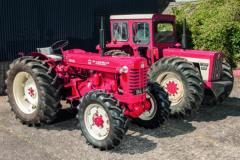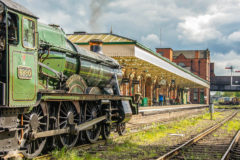Great eight-leggers!
Posted by Chris Graham on 23rd August 2021
Ed Burrows spotlights more great eight-leggers, including the Guy 8×8, the Scammell and Foden 8x6s, plus a variety of US tractors and trucks.
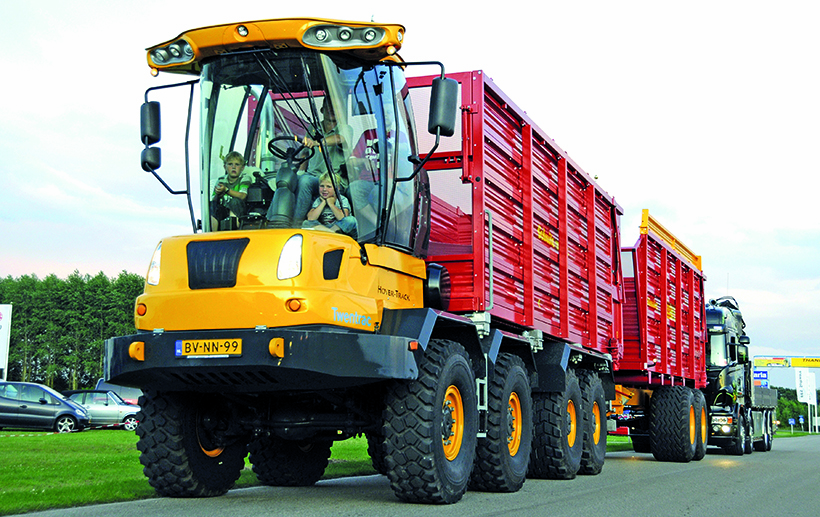
Great eight-leggers: Some years back, Netherlands agriculture vehicle specialist, HoverTrack, produced 8x8s like this on Iveco chassis. GVW was 42 tonnes, payload 29 tonnes.
Between 1928 and 1933, five different British manufacturers produced experimental or pilot-batch all-wheel-drive eight-leggers. The configuration, therefore, preceded the four-axle commercials with undriven front-ends that became the backbone of UK road haulage from the mid-1930s until the mid-1960s.
But like so many great inventions and innovations originating in the UK since the 1940s, the traction advantages of four driven axles have been exploited to a far greater extent elsewhere. No wonder we Brits could claim credit for inventing the concept of good sportsmanship (aka, being a good loser).
Research indicates the claimant to being the first-ever 8x8s were the B10E gun-tractors designed by Armstrong Siddeley, a British engineering group.
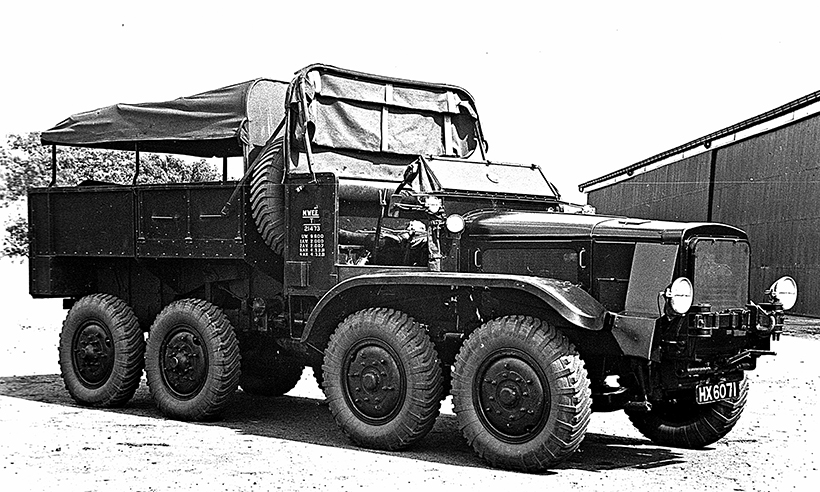
Guy’s 8×8 artillery tractor prototype of 1930 performed successfully, but was rejected for Royal Artillery service due to complexity and cost.
Quirkily, the initial version was powered by a five-cylinder, 75hp, water-cooled aircraft radial engine. With front and rear wheel pairs mounted on walking beams, steering was by articulation of the separate front and rear chassis units. More of a contraption than a truck, it was certainly a pioneer of the pivot-steer principle characteristic of earthmoving plant and specialist on-/off-highway load carriers.
In parallel with the Leyland and AEC civilian 8x8s described in Part One last month, the War Office’s Mechanical Warfare Experimental Establishment tested bonneted 8x8s built by Morris-Commercial and Guy Motors. Unremarkable in appearance – apart from the twin, front drive/steer axles – the normal control Morris-Commercial had skinny tyres (with twin rears), a straight bonnet with side louvres, canvas cab top and horizontally-split windscreen glass. All-in-all, its appearance reflected the primitive perpendicular style typical of British cars of the era.

Too late for Second World War service, the 1939 Latil M4TX prototype artillery tractor featured first and fourth axle steering, and a rear spade anchor.
Equally vintage-looking – replete with a pram-type canvas hood over the driving compartment – was the four-axle development of the 6×6 artillery prime movers supplied by Guy Motors, Wolverhampton, for army service in India. The petrol engine was a 96hp six-cylinder. With a 7.5-ton drawbar pull and equipped with a seven-ton winch, the chassis was engineered to allow considerable flexibility. The rear axles featured worm drive. The front axles were driven via a (troublesome) bevel-gear pinion system incorporating separate layshafts on the left and right of the chassis. Back-to-back tests conducted in 1931 showed that, although impressive, the performance advantage compared to the Guy 6×6 tractor from which the 8×8 was evolved, was insufficient to justify the added cost and technical complexity.
AEC exported trucks in kit form to the USSR for local assembly. This perhaps explains why two of the four AEC 8x8s described in Part One, were supplied to the Soviets – who, not long after, built the JAG-12 bonneted 8×8. Mobility lessons were obviously learnt. During the Cold War in the 1960s, when NATO was reliant on tank transporters hauled by 6x4s and 6x6s, the Warsaw Pact countries began fielding 8x8s – by the thousand.
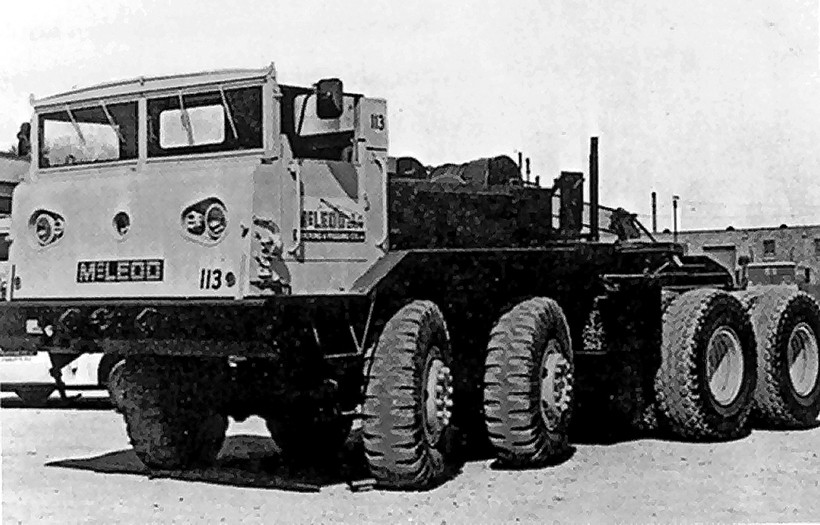
The US Army’s 1950s experimental XM194 series was re-engineered by Kenworth, in which form its 540hp Continental V8 was replaced by an 825hp V12. It later entered civilian service.
The 1930s also saw prototype 8x8s emerge in Germany and France, though none made it into production. Neither of Germany’s two 8x8s of that era made it into quantity production. Mercedes-Benz produced the 100hp diesel-engined LG65/4, and MAN the 120hp diesel-engined MAN 2-/2.5-tonner. Bother were of bonneted configuration.
Inevitably, France’s spade anchor-equipped Latil M4TX artillery tractor of 1939 was abandoned with the onset of the Second World War. Of bonneted layout, the axles were equally spaced, and the lead and the fourth axle were steered. The spec included 12.75-24 tyres, lockable diffs and an 11.2-litre, six-cylinder petrol engine producing 140hp.
Although in recent years, Nicolas Tractomas has built 8×8 ballasted prime movers, two other big French 8×8 projects – the Berliet 1950s/1960s T12 tank transporter and the PRP-Willème TG300 – didn’t make it to series production. Promoted as a 1,000-tonner, the TG300 was offered as prime mover or a rigid-platform tank transporter. Design rights were acquired in 1979 by MOL. The Belgian niche markets specialist produced a small number of ballasted prime mover variants with 300-tonne pulling power. With towing capacities of up to 500 tonnes, in more recent years, MOL has built special-order 8×8 ballast-box tractors in both bonneted and cab-over configurations, typically with Cummins power.
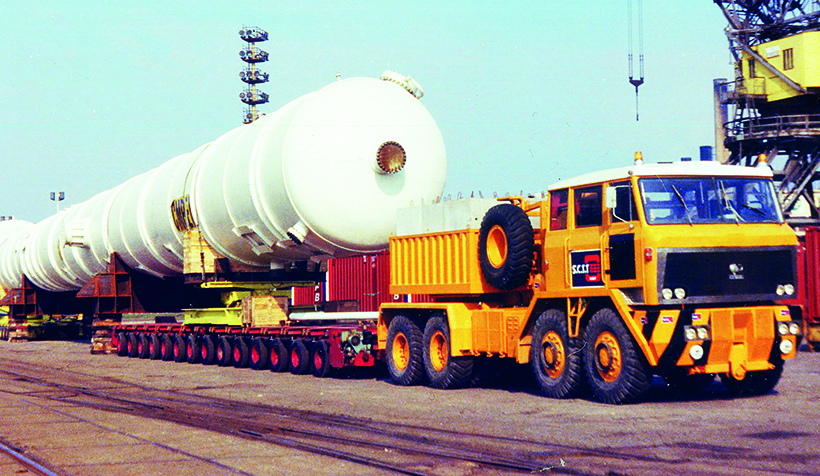
The PRP-Willème TG300 was offered in ballasted prime mover and rigid chassis tank transporter specs. It was later built in small numbers by MOL, Belgium.v
During the Second World War, and over the decade that followed, US Army equipment planners were bitten by the ‘big is best, but bigger is even better’ bug. Abandoned as being too big by half – or, more charitably, possessing capabilities too far ahead of their time – were the 1950s cab-forward Detroit Arsenal XM193 cargo truck and the XM194 tractor series. Initially powered by a 540hp, air-cooled Continental V8, the project was subsequently handed to Kenworth for re-engineering. What emerged was a leviathan with a Continental gasoline V12 producing 825hp. When unveiled in 1955, it was the world’s most powerful truck – and has seldom been topped since.
Around this time, the US Army also experimented with a tank transporter comprising two 560hp 8×8 tractors, one pulling, the other pushing, with double gooseneck load platform suspended between them.
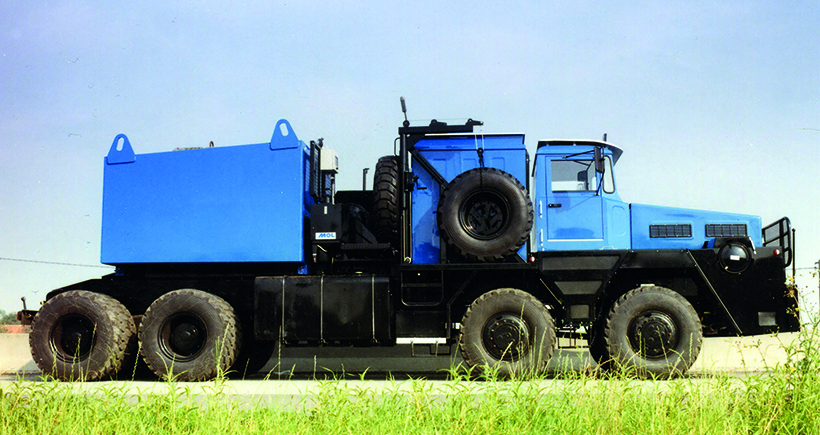
This Cummins-powered MOL 8×8 ballast tractor is good for towing up to 500 tonnes. The Belgian custom-builder also supplied the equivalent in forward-control guise.
Since the late 1950s, the USSR has variously prototyped, experimented with and manufactured 8x8s of every conceivable layout and design variation. For example, the BAZ-931 cargo truck had an underslung rear engine. And the three-tonne payload/ten-tonne gross ZIS-E134 had a long engine hood and equal wheel spacing.
Entering production in 1958, the ubiquitous MAZ- 535/-537 series of cargo/drawbar prime movers and tank transporter tractors, had the engine mounted to the rear of the cab. Produced by the Minsk Wheeled Tractor Plant in Belarus, they were the world’s first heavy trucks with independent suspension (and, in this respect, far in advance of almost all Western sports or saloon cars). The specs of the MAZ- 535/-537 series included a V12 tank diesel engine de-rated from 525 to 375hp and semi-automatic transmission.
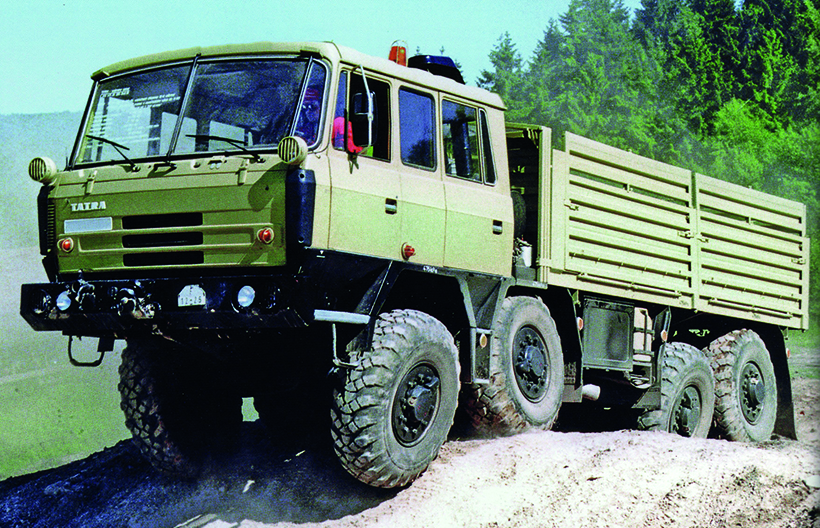
Czech Republic make Tatra introduced 8x8s in the late 1960s. Clearly evident here is its swing-arm independent suspension.
The intimidating-looking MAZ-543 and its many truck and SCUD launcher and other missile system iterations were as different again, with twin narrow cabs, one on each side of a 375hp tank engine. Sporting the Volat nameplate, since the break-up of the USSR, MZKT has introduced a series of 8×8 rigids and tractors for oilfield and military applications, with payload ratings of up to 136 tonnes. Engines have typically been German- or US-sourced. The sheer variety of distinctive forward and normal-control designs is exceptional. However, some of these may have been for purely marketing image purposes, with few entering even limited production.
NATO nations aren’t so pally with Belarus these days, and Western-supplied items for military equipment raise strategic questions. Nevertheless, the listed engine of the present top-of-the-range, cab-forward configuration Volat 8×8 tank transporter tractor, is an 812hp Caterpillar C18.

More than a generation before equivalent Western 8x8s came into service, the MAZ-537 tank transporter had over 500hp – and independent suspension.
During the time what’s now the Czech Republic was a Soviet client state, Tatra introduced a different take on 8×8 truck design. Its tube-frame, swing-axle independent suspension T813 debuted in 1966, and has been progressively developed in the decades since.
Inevitably, the all-terrain dynamics of the Soviet 8x8s established performance benchmarks that NATO – the US in particular – was compelled to follow.
After West German rearmament in the mid-1950s, MAN and Faun designed 8x8s for the Bundeswehr’s second generation of heavy trucks and tractors. The MAN KAT1/SX tactical truck series debuted in 1976. Faun’s 730hp Mercedes (later Deutz)-engined SLT-50 Elefant tank/heavy equipment transporter tractor also entered service during the 1970s. A decade on, Faun introduced the normal-control Goliath 8×8 for the civilian heavy-lift market, notably operated by ALE, Staffordshire.
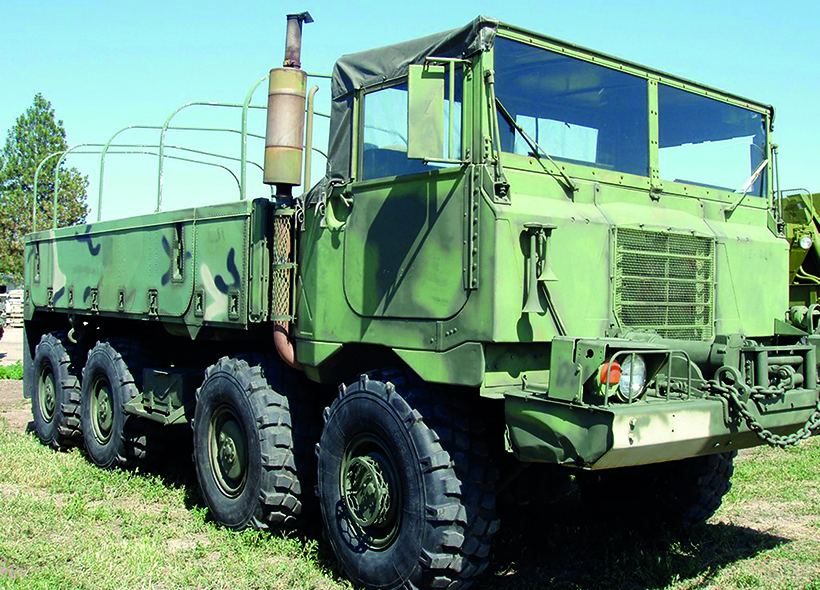
The aluminium-structure Ford M656 5-ton amphibious cargo truck, the US Army’s first 8×8. It weighed six tons unladen, two tons less than equivalent 6x6s.
The US equivalent of the MAN KAT1/SX series is the Oshkosh HEMTT 10-ton rated 8×8 tactical truck family, with Cummins or CAT power and continuously developed after becoming operational with the US Army in 1982. But the HEMTT wasn’t the US Army’s first 8×8. It was preceded by the cab-ahead-of-engine Ford M656 series of five-ton Pershing missile system support vehicles, prototyped in 1964. Amphibious, with propulsion provided by the tyres, the aluminium-structured M656 was two tons lighter than the equivalent M41 6×6 cargo truck.
In 1973, Ward La France commenced production of M746 tractors deployed – at least initially – by the US Army for transporting disabled tanks. Powered by a 600hp Detroit Diesel turbocharged two-stroke V12, the M746 was the US counterpart to the Faun SLT-50 Elefant for the subsequently abandoned joint US-German main battle tank project. Although 125 were produced by Ward La France, the M746 was originally designed by the Chrysler Corporation (which, together with its former US Dodge commercial trucks line, used to have military truck interests).

With deliveries of more than 3,000 units commencing nearly 30 years ago, the Oshkosh M1070 series is the US Army’s standard tank/heavy equipment transporter, and also serves the British and other armies.
Capitalising on its civilian-derived M911 6×6+2 that became the US Army’s standard tank/heavy equipment transporter tractor in the 1970s, Oshkosh was awarded contracts for its successor, the tridem-bogie 8×8 M1070 series. Some 3,000 have been delivered since 1992. The original 500hp Detroit Diesel V8 was subsequently replaced by a 700hp CAT teamed with Allison torque converter/Oshkosh transfer-box transmission system.
Given the production volume enjoyed by the M1070 series, purely on unit cost, Unipower’s more powerful – and probably more capable in terms of performance over poor terrain – MH8875 heavylift tractor didn’t stand a cat in hell’s chance. Intended as the British Army’s replacement for the Scammell Commander, the 750hp Cummins powered 8×8 lost out to a Private Finance Initiative contract awarded by the Blair-Brown Government. This uses Oshkosh M1070s.
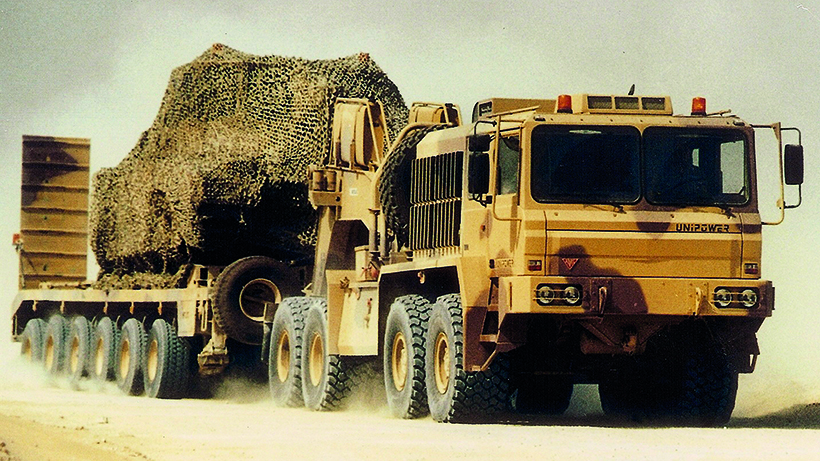
Unipower’s 750hp MH8875 prototype had a second life as Abnormal Load Engineering’s lead prime mover. ALE subsequently used the design as the basis for its in-house engineered Trojan 8x8s.
For novelty and rarity, not to be overlooked were 8x8s produced a few years back by Netherlands specialist Hovertrack. A few years back, its creative take on agriculture-market trucks resulted in eight-wheel-drivers using Iveco running units – and fitted with all-glazed farm tractor cabs. Looking like a space-age truck from a 1950s comic book, a Hovertrack 8×8 must be an odds-on cert as a classic-to-be.
The Ministry of Defence wallahs in Whitehall are notorious for procurement projects that are plagued with spec changes, go over budget and often years late into service. Given the traction advantages of an 8×8, it can only have been expediency that drove the MoD to impose an 8×6 drivetrain for the DROPS (Demountable Rack Offload and Pickup System) logistic trucks that entered British Army service in the 1990s.
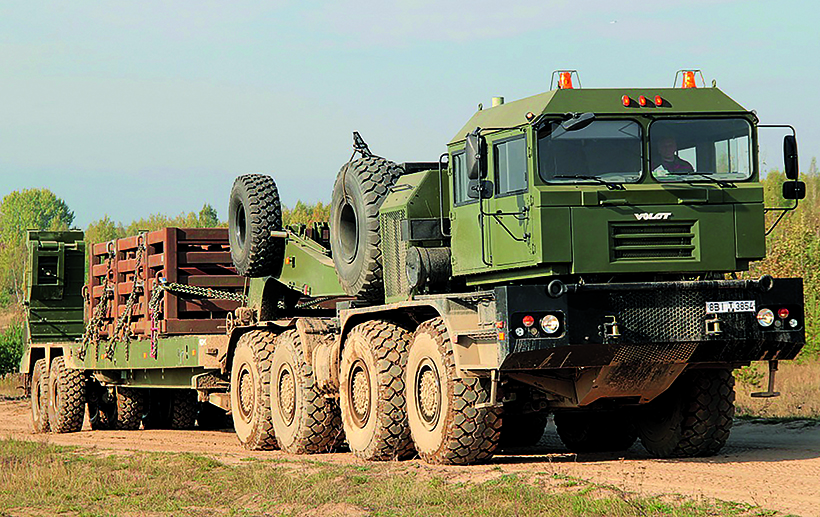
No apologies for including this aggressive looking military heavy-lift tractor built in recent years by MZKT Volat, Belarus. Rated payload is 56 tonnes.
In minimising the effects of the inevitable performance compromises, the engineers responsible for the Scammell and Foden 8x6s saved the MoD’s bacon. The 30-tonne gross ‘Improved Medium Mobility’ rated Foden DROPS truck is 2.9-metres wide and runs on 20.5×25 flotation tyres. Power is supplied by a 350hp Perkins Eagle, which transmits through a ZF 6-speed auto. Off-tarmac mobility is helped by a diff locking front steer/drive axle and inter-axle and cross-axle locking on the rear bogie. Astonishingly, although prototyped in 1984, production of the 400-unit fleet didn’t commence until 1993. MoD shilly-shallying?
The 30.5-tonne gross ‘Medium Mobility’ rated Scammell S26 was principally designed for on-tarmac operation. Like the Foden, the S26 DROPS was Perkins Eagle-powered and given ZF automatic transmission. Tyres were 18R22.5s. Production of some 1,500 trucks commenced in 1986. However, as part of the Thatcher government’s dismemberment of the British Leyland/Rover group, Scammell was ceasing to be. Production was therefore undertaken at what is now the DAF plant, in Leyland. The S26 DROPS trucks weren’t actually Scammell’s first 8x6s, seven special motorway gritter/snowploughs having been built for the Ministry of Transport in 1959-60.
The in-service overlap between the obsolescent Scammells and Fodens and their MAN 8×8 replacements, took place while all three types were deployed in Afghanistan. Where the climate is decidedly intemperate. Winter snow can be up to two feet deep. In the burning heat at the height of summer, temperatures reach 50-plus degrees Celsius.
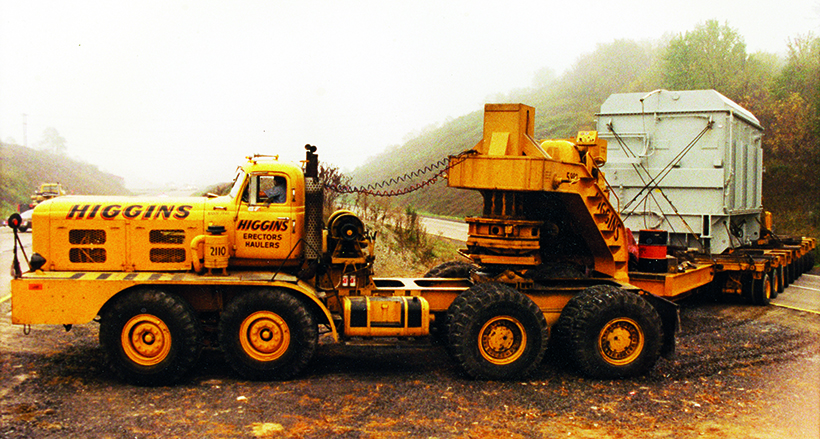
Hendrickson’s ‘Big Henry’ was an uncompromised, no-expense-spared one-off designed from first principles as the ideal indivisible load prime mover. It began than five decades of service in 1964.
Uncomfortable enough in short-sleeved attire; imagine how exhausting it was for crews wearing full combat kit, including body armour, and being on constant alert for the slightest hint of the Taliban. Typical deployments comprised 250-km round trips between the British Army’s main Camp Bastion base and hellhole forward bases in Helmand province. The 8x6s were showing their age. For their survival-minded crews, it was as much a case of nursing as driving them.
The MANs had the advantage of air-con, but suffered a downside that imposed unforeseen logistics problems. The Perkins (ex-Rolls-Royce) Eagles powering the Scammell and Foden DROPS trucks could run on anything from chip fat to standard military issue JP-8 (which fuels everything from fighter jets to tanks and trucks). In contrast, the Euro 4 spec MANs struggled to run on JP-8, and on the poor-quality local diesel.
Regardless of cost or circumstances, some operators will not accept compromises. And there’s no better example than New York State heavy-lift specialist, Higgins. Close collaboration between Higgins and former custom-builder Hendrickson produced Big Henry. A purpose-engineered one-off with an operational life spanning more than five decades, it entered service in 1964. Its twin-steer, long-hood layout distinguished it from almost any truck that went before. Weight distribution was planned so that, regardless of the load imposed on the chassis, front tandem-axle steering effort would always be optimal.

Scammell’s self-loading/unloading DROPS 8×6 was design primarily for on-highway operation. Scammell was headed for closure when the contract was awarded, so 1,500-were built at Leyland.
In relation to markers and your sightlines, the long engine hood proved an aid rather than a handicap. And the more centrally-located cab, with its wide rear window, ensured a perfect view of what was happening behind – which Higgins considered as important as the view ahead.
The spec included a 28-litre Cummins V12 diesel, with maximum outputs of 525hp at 2,100rpm and 1,443-lb.ft at 1,475rpm, handled by the combination of an Allison six-speed constant-mesh Torqmatic with full power shifting, automatic lock-up in all gears, a torque converter with a PTO, a three-speed auxiliary box with drum brake, and planetary double-reduction drive axles mounted on a 75-ton capacity leaf-sprung walking beam. The front-end spec included a combined axle capacity of 40 tons. With a 14in deep I-beam chassis beams with 8in wide flanges, and a 50-ton first line pull winch, Big Henry proved to be the prime mover with everything, whether operating in fifth-wheel or drawbar configuration.
Performance? Grossing 500 tons on its very first job, the 8×4’s retardation power was such that in handled a mile-long 15% downgrade without the brakes being touched.

During the 1990s, Foden built a fleet of 400 enhanced cross-country mobility DROPS 8x6s. The type is seen here in British Army service, operating in harm’s way in Afghanistan.
As Britain’s Number One when it came to custom-spec and series production prime movers, it’s only right that we should end with a Scammell eight-legger that was – and another that wasn’t.
Foreshadowing later 8×4 TIR/STGO heavy-hauler specials variously built by Scania for example, or as conversions, the one-off tridem-style Scammell Samson appeared in 1970. Designed to overcome kingpin-imposed load problems, it had a 27-ton capacity double-drive bogie with an (undriven) steered lead axle. The cab, like the GM Detroit 290hp two-stroke V8, were from its Crusader sibling. Rated gross train weight was 75 tons. Regrettably, only one Samson was built – but it gave a decade of service with Pickfords.
And wouldn’t we all like to see the drawings of the Watford 8×8 tractor that never was, patented during the Second World War by Scammell automotive engineering genius OD North?
For a money-saving subscription to Heritage Commercials magazine, simply click here



